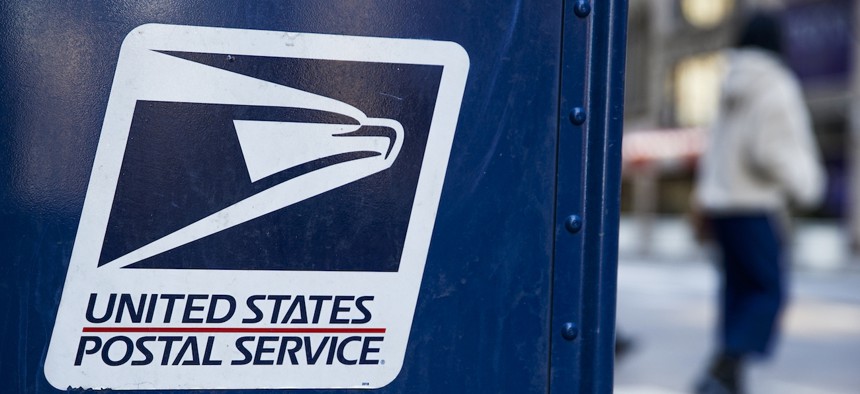
The initial consolidations are expected to begin as soon as next month. John Smith/VIEWpress via Getty Images
USPS Lists Hundreds of Post Offices and Other Facilities Where It Will Consolidate Operations
The changes will take place as soon as next month.
More than 200 post offices and other U.S. Postal Service facilities are set to shed some of their operations as soon as this year as the mailing agency seeks to consolidate those functions at larger buildings, according to documents shared by management.
The changes will mean letter carriers no longer go to their local facility to pick up mail for their route, instead traveling farther distances after starting at a consolidated location. The impacted post offices will still conduct their retail operations, but many of the back-end functions will be stripped away and relocated. They are connected to an initial 10 buildings that USPS previously announced it was standing up in previously closed facilities, as well as an additional 11 centers.
Most post offices around the country operate as delivery units, meaning mail carriers go to them to pick up mail and packages for their routes before bringing them to homes and businesses. Postmaster General Louis DeJoy has repeatedly decried this model, saying it is inefficient and can lead to as many as dozens of such units in one metropolitan area. Instead, he is looking to open “sorting and delivery centers” around the country, as well as larger mega-centers, that can take on more work in less space. Letter carriers will have to travel farther to take mail to its final destination, but DeJoy said it will save costs on the contracted trucks that USPS hires to bring mail between various facilities.
The impacted sites are located in Georgia, New York, Texas, Florida, Michigan, Pennsylvania, Ohio, Kansas, Maryland, Massachusetts, West Virginia, Kentucky, Washington, North Carolina, Indiana and Arkansas. The initial consolidations are expected to begin as soon as next month.
Employee groups have criticized postal management for failing to detail the impact of the changes on the workforce. Letter carriers will have to travel to new locations to start their routes, clerks will have to relocate to new facilities and some postmasters could be out of a job or forced to find a new one. Overall, USPS said the plans will add between 5% and 10% new routes, meaning more letter carriers would be required. The Postal Service expects to add as many as 124 city routes and 78 rural routes just as part of the initial 10-facility pilot.
In a message to members this week, the American Postal Workers Union said it has still received little information about the changes.
“We have not been given the number of employees impacted, where excessing may occur, nor when any excessing may happen,” said Charlie Cash, APWU’s industrial relations director. “We have not been told where the number of employees will increase either, because there is a chance that can happen as well.”
He added the union was “seeking and demanding more information.”
The Postal Service has said the new centers will improve the working environment for employees, reduce time and cost for transportation facilities and allow for more efficient delivery routes. Earlier this month, Dave Partenheimer, a postal spokesman, said the changes would allow USPS to purchase a greater share of electric vehicles as it overhauls its dated fleet, but did not specify the direct impact on employees.
“The Postal Service will adhere to all legal, statutory, contractual, and regulatory requirements as we evaluate a potential nationwide rollout of this initiative,” Partenheimer said.
Edmund Carley, president United Postmasters and Managers of America, previously told Government Executive that his members expressed outrage over the plan, as post offices that have only retail offerings and not back-end mail processing typically do not have a postmaster on site. Those supervisors are now worried they will be out of a job.
“I’m trying to talk them all off the ledge but I don't have answers,” Carley said.
He pledged to consult with postal management to try to find better solutions. Failing that, he said, he will work with USPS to offer early retirement or to find new landing spots for impacted personnel. His members are non-union, whereas APWU has suggested it could file a national dispute to block the changes. In a recent letter to employee groups, James Lloyd, USPS' director of labor relations policies and programs, reiterated that “any movement of employees and related regional and/or local notifications will be done in accordance with the respective collective bargaining agreements.”
DeJoy has highlighted the consolidated delivery plan as a key tenet of his 10-year plan for USPS to break even, saying it will standardize operations, lower costs and improve working conditions for employees. In a recent meeting of the postal board of governors, DeJoy implored stakeholders not to stand in the way of his reforms, saying his efforts were both common-sense and urgent.
“Initiatives by stakeholders to delay the simplest of our operational changes to integrate our network, improve our service and reduce our cost are relics of our failed strategies of the past,” DeJoy said earlier this month.







